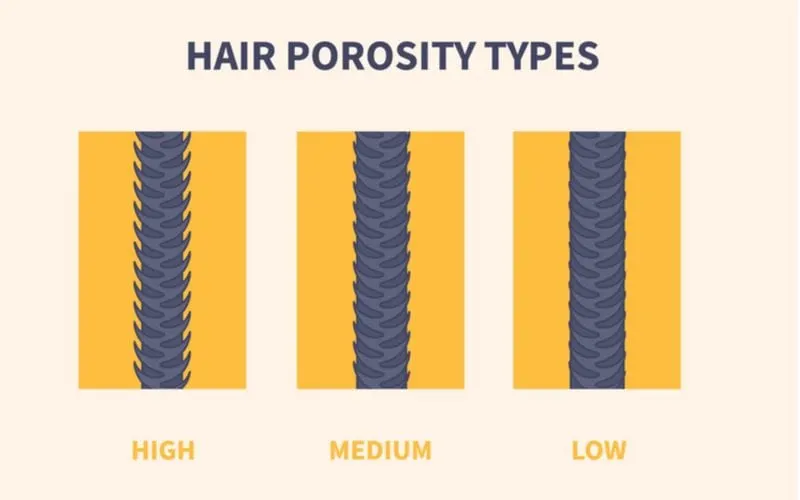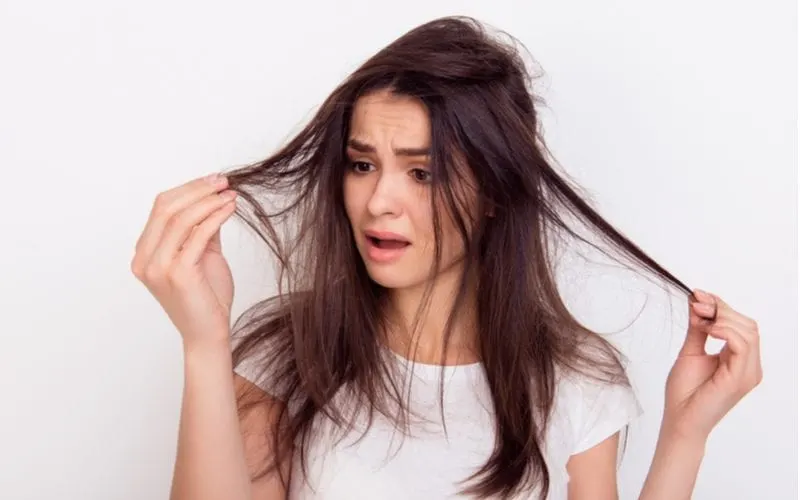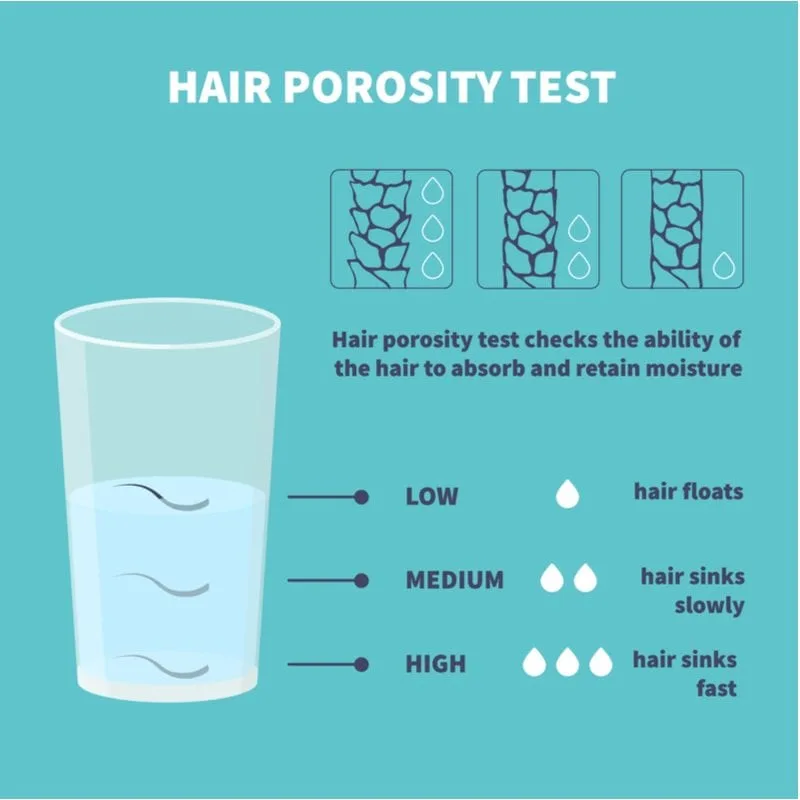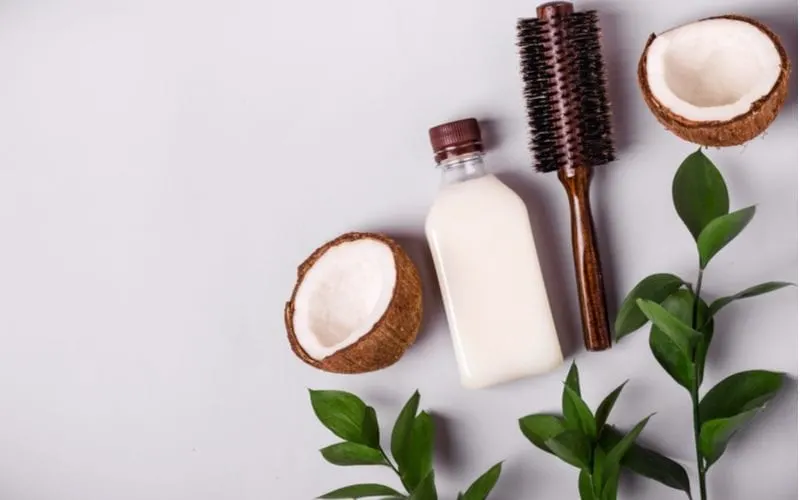Jump to:
Wondering “What is hair porosity?” We lay it all out in simple terms and explain how your hair porosity level – low, medium, or high – dictates the hair products you should use and which you should avoid!
What Is Hair Porosity?

Art4stock/Shutterstock
If you’ve started taking a more active role in managing your hair health, you’ve probably come across the term “hair porosity.” What is hair porosity?
Turns out, the porosity of your hair, whether it’s low, medium, or high, is a really important part of building the right hair care routine.
Hair porosity is a measure of how porous your hair is. That determines how well your hair absorbs moisture and retains it.
Your hair’s porosity is the reason it either soaks up product the second you apply it (high porosity) or seems to get buried under the weight of any product you put in (low porosity).
We’ll take a close-up look at low, medium, and high hair porosity in this guide. You’ll see tips for each level of porosity and steps you can take to make your hair healthier.
We’ll also show you an easy test to find out your hair’s porosity level. Let’s get started!
Read Next: Hair Porosity Quiz
Understanding Hair Porosity

Roman Samborskyi/Shutterstock
Hair porosity is a measure of how absorbent (or non-absorbent) your individual strands are. It also determines how well your hair can retain the moisture it absorbs.
Your hair porosity depends on the structure of your hair on a microscopic level. It’s partially determined by your genes, but your daily hair habits and routines play a role, too.
Regularly processing your hair with chemicals, heat styling, using harsh shampoos and products, and UV overexposure can make your hair more porous than it naturally is.
Here’s how hair porosity works.
Every strand of human hair is covered by a layer of tiny cuticles, which are cells that resemble shingles on a roof.
When the cuticles are overlapping and packed closely together (low porosity), it’s harder for water, oils, and nutrients to get through them and access the inner structure of your hair strands. Just like shingles are laid closely together to prevent water from entering your roof!
When the cuticle layer is lifted out a bit more (medium porosity), they allow water, oils, and nutrients to enter the strands. They also prevent too much moisture from leaving the strand. Medium porosity hair’s “shingles” (cuticle layer) are raised up slightly, so they still do their job. But they allow more moisture in and out than low porosity hair.
When the cuticle layer is lifted out considerably (high porosity), the individual cells don’t overlap much at all. The result is crazy-high hair absorbency.
Moisture, oils, and nutrients are free to enter. But that moisture leaves just as easily as it came in because the cuticle layer isn’t locked down tight.
But…
- How can you determine your hair’s porosity?
- Which level of hair porosity is the best?
It turns out, there’s a simple test you can do to find out your hair’s porosity — and we’ll show you how to do it. Then, we’ll take a close-up look at low, medium, and high porosity hair characteristics and how to care for each type.
How to Determine Your Hair Porosity

Art4stock/Shutterstock
It’s so easy to find out what your hair porosity level is. You can do it right now! Go grab a glass of water and a strand of your hair to do the simple hair porosity test.
Add a single strand of your hair to a full glass of water. Make sure your hair is clean and doesn’t have any products on it to get the most accurate results. Give it a minute or so to see how it interacts with the water.
You’ll see one of three things happen:
- The hair floats at the top. This indicates you have low porosity hair that is resistant to moisture. It won’t absorb the moisture quickly, so it floats on top instead.
- The hair floats at first, then sinks to the middle of the glass. This indicates you have medium porosity hair. It takes longer to absorb moisture, but eventually lets some of it in and sinks a bit in the glass.
- The hair sinks to the bottom of the glass right away. This indicates you have high porosity hair that absorbs water very quickly.
You can also try the “strand” or “slip n’ slide” test to determine your hair porosity.
Grab the end of a strand of your hair and squeeze it between two fingers. Now, slide your fingers up the strand toward your scalp and pay attention to what you feel along the way.
Observe the results:
- If it feels smooth all the way up the strand with no bumpy spots, it’s likely low porosity hair.
- If your fingers easily glide up but you detect some bumpy areas along the way, you likely have medium porosity hair.
- If you feel little bumps as you slide up the strand, you likely have high porosity hair. The “bumps” you’ll feel are areas where the cuticle layer is raised along your hair strand.
Find your hair porosity level below to learn about what your hair needs, what you should avoid, and how to best care for your hair.
Low Hair Porosity

Oleksandr Panasovskyi/Shutterstock
Low porosity hair tends to be shiny because the cuticle layer is flat and smooth. It resists moisture and doesn’t absorb moisturizing hair products very well. You can sometimes see water bead up on low porosity hair because it struggles to absorb it.
If you’ve ever applied a curl cream, leave-in conditioner, or hair mask and felt like it just sat on top of your hair, you might have low hair porosity.
Low porosity hair:
- Air dries slowly
- Requires more time to saturate with water
- Doesn’t easily absorb moisturizing hair products
- Requires longer processing times for chemical services
- Appears glossy, shiny, and smooth when healthy
Buildup is a common problem with low hair porosity. Since this type of hair won’t readily absorb moisture and nutrients, they tend to sit on top of the hair and build up over time. Protein-based hair products are a no-no for low porosity hair.
Protein overload, where strands become stiff and hard from an overdose of unabsorbed protein, is a common concern. It’s not a bad thing to have low porosity hair.
You just need to take a few extra steps to ensure your hair can get the moisture and nutrients it needs. Gentle heat helps coax the cuticle layer to open slightly to allow the good stuff in.
Try applying a deep conditioning treatment or moisturizing hair mask (no protein!) to your hair, then cover with a shower cap to trap some of your body heat.
For the best results, you can use a thermal conditioning cap like this to apply gentle heat while you’re deep conditioning. Steam treatments are another great option for low porosity hair.
The best part is that once you stop applying heat, the cuticle layer will close right back up. That means the moisture absorbed during your deep conditioning sesh is sealed in. That’s the key to soft, shiny, smooth hair!
Medium Hair Porosity

Oleksandr Panasovskyi/Shutterstock
You don’t hear as much about medium hair porosity as you do about low and high porosity. Medium hair porosity is sometimes referred to as “normal porosity.” This porosity level absorbs more moisture than low porosity hair, but not as much as high porosity hair.
The cuticle layer is slightly lifted in medium porosity hair, so more moisture and nutrients are allowed in. But since the cuticle layer is lifted, it’s harder to “seal” moisture into medium porosity hair than low porosity hair.
Medium porosity hair:
- Processes faster than low porosity hair
- Appears glossy and shiny when healthy
- Air dries somewhat fast
- Doesn’t take long to saturate with water
- Holds styles for a longer duration
Buildup can be a problem for medium porosity hair. Although the cuticle layer is lifted more than low porosity hair, it’s still tight enough to keep some products and moisture from penetrating the hair shaft.
The key to healthy medium porosity hair is finding the right moisture balance. You want to provide enough moisture to satisfy your strands’ needs without overwhelming them to the point of creating buildup.
Try using a gentle clarifying shampoo or apple cider vinegar hair rinse weekly to clarify medium porosity hair and remove any traces of product buildup. ACV has the added benefit of helping the cuticle layer lie flat and prevent your hair from becoming highly porous.
Don’t skimp on moisturizing products if you have medium porosity. Your hair has a pretty balanced moisture in-moisture out policy. So ensuring you’re working additional moisture in regularly keeps your hair from drying out and becoming brittle.
You also don’t have the same issues with protein overload as your low-porosity kinfolk. So feel free to experiment with shampoo, conditioner, hair masks, and treatments that contain protein.
But be watchful for any increase in dryness, brittleness, or breakage in your hair that might point to protein overload. If your hair begins to feel like straw at any point, stop using products that contain protein and focus on moisturizing products instead.
High Hair Porosity

Oleksandr Panasovskyi/Shutterstock
High porosity hair has a lifted cuticle layer. Imagine shingles on a roof that have been lifted up by a storm. When hair is highly porous, it allows tons of moisture in. Sounds great, right?
The problem is that highly porous hair lets all that moisture run right back out as quickly as it came in.
High porosity hair:
- Tends to look dull and dry
- Air dries very quickly
- Quickly absorbs moisturizing hair products
- Is easily saturated with water
- Is prone to breakage and tangles
- Can becomes overly processed very easily (use chemicals with caution)
High porosity hair has a feast and famine complex. It absorbs moisture and nutrients like a sponge, but it can’t retain moisture because of the highly lifted cuticle layer. You might find that no matter how much you moisturize your hair, it still seems thirsty.
It’s hard to overload high porosity hair with protein because it absorbs it so well. So unlike low and medium porosity hair, you don’t have to monitor your protein-based product usage as closely.
The key to caring for high porosity hair is minimizing further damage and meeting the hair’s intensive moisture and protein needs. This means skipping or limiting chemical processing, heat styling, and UV ray exposure.
These all cause the cuticle to lift further, exaggerating your moisture loss. Look for intensive moisturizing products that contain oils (like coconut, hemp seed, and castor) that help seal moisture into the hair shaft.
Small changes can mean big rewards for high porosity hair. Switch from blow drying to air drying (it doesn’t take long with highly porous hair, anyway). Find easy hairstyles that don’t require hot tools.
Switch to gentler low pH shampoo to protect your strands. All of the above will encourage your hair’s cuticle layer to lie flat and prevent excess moisture loss. Our favorite tip for highly porous hair is applying a moisturizing hair mask before shampooing.
This allows your ultra-absorbent locks to drink in all the moisture they want before being subjected to a shampoo cleanse and regular conditioner. The result is moisturized, stronger hair that remains nourished through the cleansing process.
If you don’t want to drop a boatload of money on salon-grade product, try a natural remedy like rice water on your hair. It’s proven to add shine and reduce frizz, and can be made for under a dollar!
Hair Porosity Dos and Don’ts

Colnihko/Shutterstock
Overall, your hair porosity level dictates how you should care for your hair. Here are some quick dos and don’ts to keep in mind for low, medium, and high porosity hair.
If you have low porosity hair…
- DO use gentle heat to help your hair absorb moisturizing treatments
- DO understand that color and perm services will take longer to process
- DON’T use protein-based hair products, which can lead to protein overload
If you have medium porosity hair…
- DO clarify the hair weekly with a clarifying shampoo or ACV rinse
- DO feel free to indulge in chemical services, but don’t go crazy
- DON’T skimp on moisturizing treatments to keep your hair balanced
If you have high porosity hair…
- DO opt for intensive moisturizing treatments that contain natural oils like coconut, hemp seed, and castor oil
- DON’T get a chemical service without doing a strand test first
- DON’T overprocess, heat style daily, or overexpose the hair to UV rays
They say knowing is half the battle. Now that you know your hair’s porosity level and what it means for your hair care routine, you can make the best decisions for your hair at every level.
Whether your hair is resistant to moisture (low porosity), balanced (medium porosity), or super absorbent (high porosity), you can choose products and techniques that deliver targeted moisture to your strands and keep them healthy, strong, and shiny.
